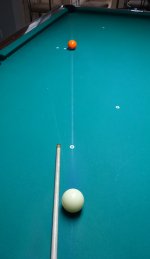This sounds like preferring to hit the same CB spot and vary the stroke speed for different distances - as opposed to hitting the same speed and varying the CB spot. This tradeoff choice has been discussed recently somewhere here.I'd hit a stop shot with the tip as low as I can shoot it.
I do the same (hit the same spot at different speeds) because I feel that I can be more precise with different stroke speeds than with different tip placements to get the same CB action at the OB.
YMMV
pj
chgo
